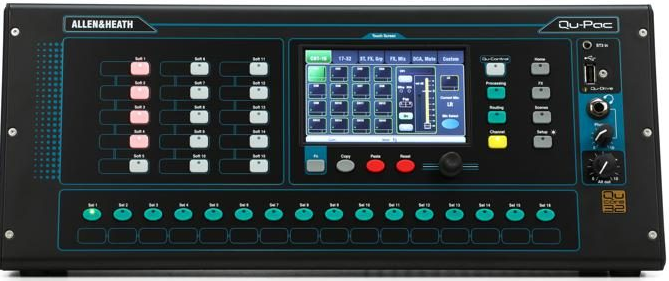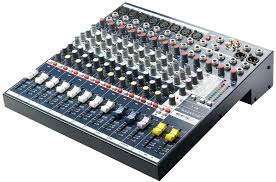As the name suggests a mixer is a device where input from various microphones (mic level and analog) are mixed, amplified, effects added, frequencies cut / boosted etc and the final line level output is sent out through various outputs. This output goes into the next equipment in the audio chain, usually the amplifier. In between the mixer and amplifier you can also have an equalizer, sonic maximizer, compressor etc to alter the characteristics of sound.
Remember we are only dealing with voice so microphone input is the most common input we will be working with in a Masjid environment. Mixers also take in line level input if there is a preamp between the microphone and mixer. Insert inputs are out of context as musical instruments are not involved in a Masjid.
Advice … People get intimated when they see a mixer with so many knobs. Little do they realize that it is basically a repetition of the same set of less than 10 knobs per channel (per mic) times the number of channels on the mixer. Once you take this fear factor out it becomes fairly easy to understand the functions of the mixer. The master section has few extra knobs but again they are very easy to learn.
There are two type of mixers … Analog and Digital.
Analog mixers give you the traditional line level analog output and cannot be directly connected to the computer. You need an audio interface to convert this analog signal into digital format. Lot of analog mixers now have a USB or Firewire output making them partially digital as they can also give a digital signal output. This digital signal can be recorded in a computer using any recording software like Audacity or ProTools. Analog mixers have rotatory knobs to adjust levels.
Digital mixers are more expensive and have more features apart from just the analog to digital conversion. One important feature is to be able to sculpt the sound a certain way and save the presets. Any preset can be recalled when desired. They also take both analog and digital inputs. They also have built in equalizer, compressors etc. In a Masjid setup this might not make a lot of sense as digital mixers are more expensive and their feature set is more geared towards musical instruments and not speech or vocals. If the mosque is enormously big with a very good budget then it might make sense to go the digital route. The digital mixers (especially the matrix mixers) that we use in projects are as follows.
Digital Mixers …
BSS Blu 800 series
These mixers use open architecture to design the system/signal flow and are used when uncompressed sound needs to be transmitted digitally to longer distances using one of the protocols – Dante / CobraNet / AVB / Blu Link. This is one of the best install mixer than can be used. These are used in the Al-Rajhi Mosque in Makkah. An inexpensive alternatives are BSS Blu 160 and BSS Blu 100 models. Most of these products are made in USA.
Biamp TESIRA Forte Series
These mixers use open architecture to design the system/signal flow and are used when uncompressed sound needs to be transmitted digitally to longer distances using one of the protocols – Dante / CobraNet etc. These are made in USA and come in various configurations and options. 
Symetrix Radius / Edge / Prism / Solus / Jupiter Mixers
This are extremely good sounding digital matrix mixers. They have really good sounding preamps and follow the open architecture to design the system/signal flow. 
Ashly ne24.24m
This is a extremely good sounding digital matrix mixer with fewer bells and whistles than the digital mixers listed above. This matrix mixer DOES NOT have an open architecture so are limited in their configuration but sufficient for a Masjid easy to use. This is one of our favorites and is hand made in US for more than 20 years. 
Yamaha MTX3
QSC Core 110f
Yamaha TF-Rack
Allen & Heath Qu-Pac
Others … Lectrosonics DM 1624 etc.
Analog Mixers …
We all like the analog sound. We only go digital after the analog output sounds perfect and we have to recorded it.
An important feature of the mixer worth considering is being able to rack mount it thereby keeping it secure from curious hands. Kids love turning knobs. This is where rack mountable mixers come into play. Our favorites from analog ones is Ashly MX508. Rane also makes good rack mountable mixers. Studiomaster makes a good model called C3X. You should be able to add some reverb to voice so an aux send and return on mixer are desirable. The worst mixer you can buy is a Behringer. Its muffled sound does not give a true representation of Arabic letters / Tajweed.
Other mixers which can be rack mounted but are a little difficult to manage include Allen & Heath Zed/MixWizard series and Soundcraft EFX/MFXi series. Makie mixers are good too. If the Masjid wants to go with the best of the breed (but very expensive) then you can take the Midas route. In Haram (Makkah and Madina) Midas and Soundcraft mixers are used.
In the most common Masjid scenario, six microphones are the maximum that will be used so no need to go with mixers that have like 16 or 24 mic inputs. Mixers that are easier to manage, adjust / retain, sound good and clear are the key combinations you should look for. All our recommendations are time tested rugged machines with very good preamps and they sound very good. There are lot of mixers out there which are cheap and thin or muffled sounding with horrible preamps and effects. Stay away from them.
We have personally owned / tested several dozen mixers and have narrowed down to the following. Our recommendations in order of our preference …
Ashly MX508
Rolls RM65b
Soundcraft MFXi8 or EFX8
Allen & Heath MixWizard3 12:2 or ZED-12FX 

There is another kind of mixer called “Powered Mixer“. This is basically a mixer and Power Amplifier built into one device. A mixer / amplifier is pretty much the same thing except that the mixer features are scaled down.
Yamaha EMX312SC Powered Mixer
RadioShack Mixer / Amplifier (Poor man’s mixer / amplifier)

